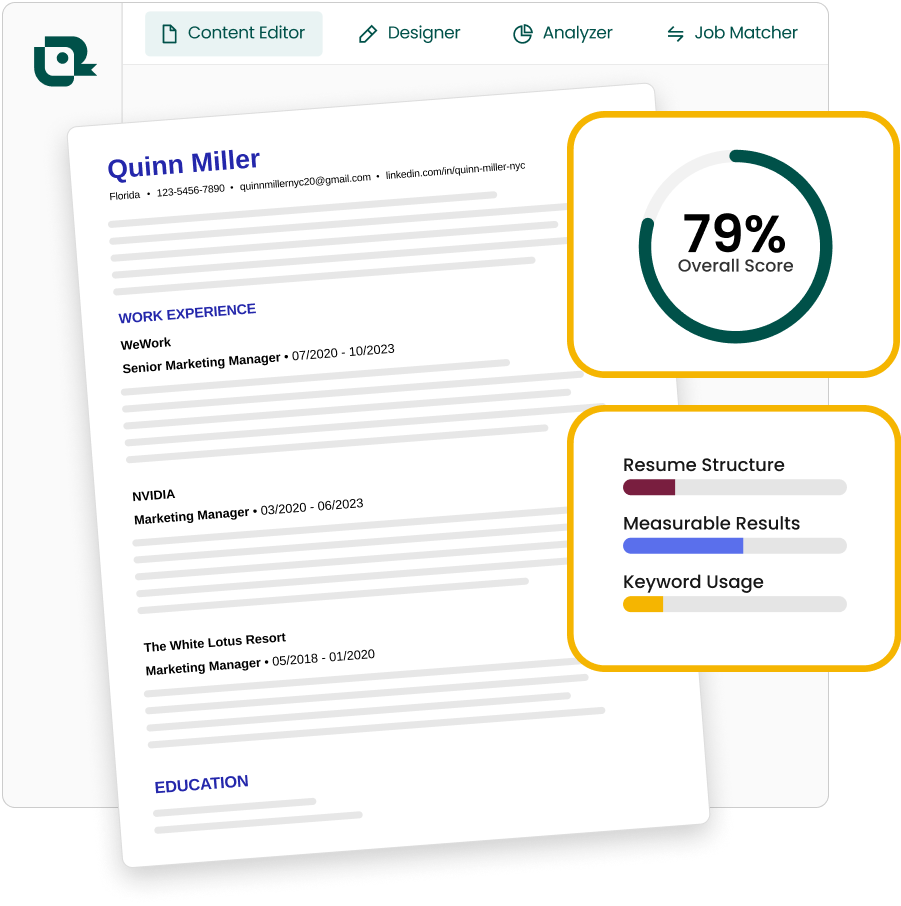3 key takeaways
- Understand why a two-page resume is not only acceptable but often recommended for professionals with 5+ years’ experience.
- Learn why your resume’s relevance and clarity matter more than the length (within limits).
- Discover how to format a two-page resume that stands out using the Teal AI Resume Builder.
Two pages might sound like too much for a resume. But if you have the experience to back it up (and format it clearly), it can actually make your application stronger. Especially for senior roles, career changers, or job seekers with lots of relevant experience, a second page gives you room to show the full picture without cramming everything into a single sheet.
This guide breaks down how and when to use this type of resume, what to include (and what to cut), and how to format a two-page resume so it’s easy to read, easy to tailor, and still gets results.
Can a resume be two pages?
Yes, a resume can be two pages, and it often should be. In fact, in a survey of hiring professionals by assessment platform Criteria, over half said that resumes should be two pages in most cases.
A two-page resume is exactly what it sounds like: a resume that spans two pages instead of one. It’s common for professionals with 5+ years of experience, a broad skill set, or additional certifications, projects, or leadership roles.
Page count doesn’t matter nearly as much as relevance. If it takes two pages to clearly show your qualifications, impact, and alignment with the role, use the space.
Now, don’t get us wrong: there is a limit on page length. As Patrick Payne, founder of PopCandi (an executive search and career support company), says, “Your resume needs to tell your story quickly and clearly. A seven-page resume has never worked—and still doesn’t.”

But a two-page resume that’s tailored, skimmable, and focused on what matters will always perform better than a crammed one-pager that leaves out the most important details. Just don't fill it with vague and unspecific information (otherwise known as “fluff”).
How to choose two pages or one
In 2025, your resume doesn’t need to be short, but it does need to be relevant. This is backed up by leaders across large public and private organizations. For instance, according to the National Institutes of Health Office of Intramural Training and Education, “a résumé should always be one to two pages,” but should also be “succinct and relevant to a specific reader or position.”
Here's how to decide which page length is right for you.
📌 Resume Myth: A resume has to be one page
This advice is everywhere, but it’s outdated. A one-page resume might work if you're early in your career, but once you’ve built experience, one page often isn't enough.
If your most relevant accomplishments spill onto a second page, that’s not a problem. A well-organized two-page resume that clearly highlights your qualifications is more effective than a crammed one-pager that leaves key information out.
Need help deciding which to use? Read Teal's guide to the one-page resume.
When to use a two-page resume
If you've built up experience or have relevant details to show, a two-page resume might be your best bet. Use this quick checklist as a guide.

When to stick to one page
If you're still early in your career or applying for your first job, one page might be all you need. But if trimming content means cutting important achievements or context, a second page can actually make your resume stronger. This quick checklist can help guide you.

💡Pro Tip: You might need a two-page resume for one role and a one-pager for another; it all comes down to what’s most relevant. Instead of starting from scratch each time, use a tool like Teal to store your full career history in one place. Then quickly pick and choose the experience that fits each job without deleting important details you might need later.
How to format a two-page resume in four steps
Your two-page resume format is important. Don’t just tack on extra space and call it done. Here are three steps to make sure both pages work together and actually get read.
Step 1: Keep the formatting consistent
Whether you opt for a reverse chronological, functional, or hybrid resume, the formatting should be consistent. Page two should look like a seamless continuation of page one, not a second document.
Step 2: Break sentences cleanly
Avoid splitting up sentences and bullet points across pages. Let each finish naturally, even if it means some white space at the bottom of page one.
Step 3: Prioritize clarity
Don't shrink fonts, mess with margins, or jam everything in just to make two pages “work” (even if that means your two-page resume becomes three pages). Let your most relevant, high-impact experience lead—and keep everything scannable.
Step 4: Use page two strategically
Page two of your resume is prime real estate for expanding on your impact. Here’s how to make it count:
- Continue your strongest experience: If your most relevant roles need more space to show measurable results, page two is where you do it. Don’t cut great bullets just to squeeze everything onto page one.
- Highlight earlier roles with relevant wins: Older experience can still matter, especially if it’s in the same industry or shows transferable skills. Use page two to give them a quick spotlight without overloading the first half.
- Include sections that support your candidacy: Certifications, technical skills, side projects, or volunteer work? If they reinforce your fit for the role, they belong. If not, leave them off.
- Remove fluffy language: No one wants to read “Responsible for…” on page one or page two. Every bullet should earn its spot.
Best practices for your two-page resume
A great two-page resume isn’t just about filling space. It’s about using that space to clearly and effectively communicate your value. These tips will help make sure both pages work hard for you.
✅ Start with relevance
- Only include content that supports the job you’re applying for
- Lead with your strongest and most recent accomplishments
- Cut older or unrelated roles unless they offer key context or skills
✅ Make both pages easy to scan
- Use consistent formatting, spacing, and section headers
- Ensure contact info is on page one and the most relevant content shows up early
- Add visual breaks (like white space and section headings) to guide the reader
✅ Use the second page strategically
- Include strong accomplishments or impact data that didn’t fit on page one
- Add supporting sections like Certifications, Projects, or Publications
- Don’t just trail off. Keep the quality consistent from top to bottom
Two-page resume examples and templates
A two-page resume doesn’t mean two hours of formatting. These templates are designed to keep things clean and scannable without cramming everything onto a one-page resume.
Two-page resume template - chronological format
This template for a two-page chronological resume is great for showcasing steady growth and relevant experience across multiple roles.
Contact Details
[Your Name]
[Phone Number] • [Email Address] • [LinkedIn Profile URL] • [Portfolio or Website URL, if applicable]
[Target Title - the job title of the position you're applying for]
Professional Summary
[3-5 sentence summary highlighting your years of experience, skills, relevant experience, and top wins]
Work History
[Job Title]
[Company Name], [Location]
[Month, Year – Month, Year]
• Bullet with metrics and impact
• Bullet with metrics and impact
• Bullet with metrics and impact
• Bullet with metrics and impact
• Bullet with metrics and impact
(Repeat for every relevant position)
Education
[Degree, Major] – [School Name], [Location]
[Graduation Date]
Skills
• Relevant Skill
• Relevant Skill
• Relevant Skill
Certifications
[Relevant certifications or licenses]
Additional Sections
Two-page resume template - functional format
This two-page resume template for a skills-based resume can be used if you're highlighting transferable skills or navigating a career pivot.
[Your Name]
[Phone Number] | [Email Address] | [LinkedIn URL]
[Target Job Title]
PROFESSIONAL SUMMARY
[3-5 sentences highlighting your most relevant skills, years of professional experience, and how your background prepares you for this new role. Focus on impact that connects your previous experience with the opportunity.]
KEY SKILLS
[Skill Category 1]
• Bullet with metrics and impact
• Bullet with metrics and impact
• Bullet with metrics and impact
[Skill Category 2]
• Bullet with metrics and impact
• Bullet with metrics and impact
• Bullet with metrics and impact
[Skill Category 3]
• Bullet with metrics and impact
• Bullet with metrics and impact
• Bullet with metrics and impact
[Skill Category 4]
• Bullet with metrics and impact
• Bullet with metrics and impact
• Bullet with metrics and impact
EDUCATION & CERTIFICATIONS
[Degree], [Institution], [Year]
[Relevant Certification], [Issuing Organization], [Year]
PROFESSIONAL EXPERIENCE
[Job Title], [Company], [City, State] | [Start Date–End Date]
[Job Title], [Company], [City, State] | [Start Date–End Date]
[Job Title], [Company], [City, State] | [Start Date–End Date]
💡Pro Tip: Explore Teal's modern resume templates to get started on your own resume.
Two-page resume examples
These two-page resume examples show how to use the second page with purpose, focusing on relevance, clarity, and real impact (not filler).
Two-page resume example - senior experience
Why this works: The sample two-page resume below uses the second page to show depth without sacrificing clarity by focusing on leadership, strategy, and results that are highly relevant to an executive role.

Two-page resume example - technical experience
Why this works: This two-page resume example for a data analyst prioritizes technical accuracy over brevity, giving space to certifications, tools, and projects that directly align with how candidates in this field are evaluated.

💡Pro Tip: Need more samples? Check out Teal's selection of over 2000 resume examples.
Common mistakes with two-page resumes
Even a strong resume can fall flat if page two feels like filler or if formatting gets sloppy. Avoid these common mistakes:
❌ Adding fluff just to fill space: Stretching bullets, listing irrelevant jobs, or tweaking margins to hit two pages weakens your message. Stick to what’s relevant, even if your resume ends halfway down page two.
❌ Inconsistent formatting between pages: Changing fonts, spacing, or headings makes it feel like two documents. Keep your layout consistent and scannable.
❌ Breaking key content across pages: Don’t split sentences or bullet points between pages. Keep stories intact so your impact doesn’t get lost.
❌ Cramping everything into one page when two would help: If your most important content feels rushed or squeezed, give it room to breathe. A clean, relevant two-page resume is better than a dense, hard-to-read one-pager.
How to share or submit a two-page resume
A two-page resume isn’t just for uploading and hoping for the best. Here’s how to make sure it looks great and works hard—wherever it ends up.
When submitting digitally
Save your resume as a PDF to lock in formatting, but only after double-checking it’s ATS-friendly. That means an applicant tracking system can parse it correctly. Avoid text boxes, graphics, or images. Keep it simple, structured, and searchable.
💡 Pro Tip: Name your file something clear and professional like Firstname_Lastname_Resume.pdf.
When printing for interviews or job fairs
Yes, people still print resumes for interviews and job fairs. But should you print resumes double-sided if they span more than one page? No. If you’re bringing yours in person, print single-sided on separate sheets and use a paperclip (not a staple). Keep it easy to flip, scan, and copy if needed.
When uploading to LinkedIn or job boards
Stick with a clean PDF for LinkedIn and major job boards. If the platform asks you to paste your resume into a text box, use your master resume and trim it down based on relevance (or let Teal help). And remember: upload tailored versions, not just your default resume. The closer the alignment, the better your chances.

Frequently Asked Questions
Is a two-page resume suitable for an entry-level position?
Yes, a two-page resume is okay for entry-level job seekers as long as the skills and experience listed are relevant to the job description.
What’s the ideal spacing for a resume?
The ideal spacing for a resume ensures it is legible, clear, and well-presented. Typically, this means line spacing of 1-1.15, paragraph spacing of 6 points before and after, and margins of 0.5”-1”.
Why do most employers prefer one-page resumes?
Some employers prefer a one-page resume because they can scan it quickly and easily identify your qualifications and experience. However, a two-page resume is completely fine if you have the experience to warrant the length.
How do you reduce a two-page resume to one page?
Rather than focusing on length, it’s important to have a strong, flexible base resume with all of your experience and skills that you can adapt and customize for each job. Create one comprehensive resume that includes everything. Then, pull the details that align with each specific job description, whether that ends up being a one-page or two-page resume format.
Is a two-page resume ATS-friendly?
Yes, a two-page resume is ATS-friendly. As long as your resume is clean, text-based (avoiding complex tables or graphics), and saved in a format like .docx or .pdf, the ATS can parse it easily. Length is not a factor.



.jpg)





